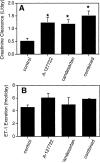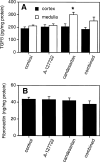Combined effects of AT(1) and ET(A) receptor antagonists, candesartan, and A-127722 in DOCA-salt hypertensive rats
- PMID: 11368889
- PMCID: PMC3939804
- DOI: 10.1016/s0306-3623(00)00079-3
Combined effects of AT(1) and ET(A) receptor antagonists, candesartan, and A-127722 in DOCA-salt hypertensive rats
Abstract
Several recent studies have provided evidence that many of the hemodynamic and mitogenic actions of angiotensin II (Ang II) are mediated by endothelin-1 (ET-1). We hypothesized that Ang II and ET-1 act synergistically to promote a decline in renal function and the development of renal fibrosis in the deoxycorticosterone acetate (DOCA)-salt model of malignant hypertension and renal dysfunction. Experiments were conducted to determine the effects of ET(A) receptor antagonism (A-127722) and AT(1) receptor antagonism (candesartan cilexetil) on the development of renal fibrosis and the decline of renal function. Surgery was conducted on male, Sprague-Dawley rats to remove the right kidney and implant subcutaneously a time-release pellet containing DOCA. DOCA-treated rats were also given 0.9% NaCl to drink. After recovery from surgery, rats received one of four treatments via the drinking solution: (1) candesartan cilexetil (10 mg/kg/day), (2) A-127722 (10 mg/kg/day), (3) candesartan cilexetil plus A-127722, or (4) untreated controls. Over the course of a 3-week treatment period, systolic arterial pressure in all groups were elevated. However, this increase was significantly attenuated in the group given combined A-127722 and candesartan, but not with candesartan alone. Creatinine clearance, used as a measure of GFR, was significantly higher in rats treated with either or both drugs. At the end of the study, renal medullary tissue was harvested for determination of TGF-beta and fibronectin content (ELISA). TGF-beta levels were not reduced by either ET(A), AT(1), or combined ET(A) and AT(1) receptor blockade. Likewise, fibronectin content was similar among groups. These studies indicate that combined ET(A) and AT(1) receptor blockade may produce some improvement on hemodynamics, but have no effect on progression of renal damage in this non-renin-dependent model of hypertension.
Figures






References
-
- Allcock GH, Venema RC, Pollock DM. ETA receptor blockade attenuates the hypertension but not renal dysfunction in DOCA–salt rats. Am. J. Physiol. Regul. Integr. Comp. Physiol. 1998;275:R245–R252. - PubMed
-
- Benigni A, Remuzzi G. Mechanism of progression of renal disease: growth factors and related mechanisms. J. Hypertens. 1998;16:S9–S12. - PubMed
-
- Border WA, Noble NA. Transforming growth factor β in tissue fibrosis. N. Engl. J. Med. 1994;311:1286–1292. - PubMed
-
- Border WA, Noble NA. Interactions of transforming growth factor-beta and angiotensin II in renal fibrosis. Hypertension. 1998;31:181–188. - PubMed
-
- d'Uscio LV, Moreau P, Shaw S, Takase H, Barton M, Lüscher TF. Effects of chronic ETA-receptor blockade in angiotensin II-induced hypertension. Hypertension. 1997;29:435–441. - PubMed
Publication types
MeSH terms
Substances
Grants and funding
LinkOut - more resources
Full Text Sources
Research Materials
Miscellaneous

